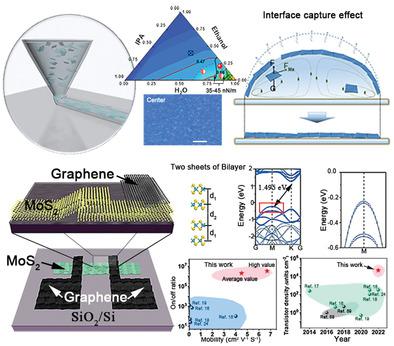当前位置:
X-MOL 学术
›
Adv. Mater.
›
论文详情
Our official English website, www.x-mol.net, welcomes your
feedback! (Note: you will need to create a separate account there.)
Interface Capture Effect Printing Atomic-Thick 2D Semiconductor Thin Films
Advanced Materials ( IF 27.4 ) Pub Date : 2022-09-20 , DOI: 10.1002/adma.202207392 Lihong Li 1, 2 , Xiaoxia Yu 1, 2, 3 , Zhaoyang Lin 4 , Zhenren Cai 1, 2 , Yawei Cao 1, 2, 3 , Wei Kong 1, 2, 3 , Zhongyuan Xiang 1, 2 , Zhengkun Gu 1, 2 , Xianran Xing 3 , Xiangfeng Duan 5 , Yanlin Song 1
Advanced Materials ( IF 27.4 ) Pub Date : 2022-09-20 , DOI: 10.1002/adma.202207392 Lihong Li 1, 2 , Xiaoxia Yu 1, 2, 3 , Zhaoyang Lin 4 , Zhenren Cai 1, 2 , Yawei Cao 1, 2, 3 , Wei Kong 1, 2, 3 , Zhongyuan Xiang 1, 2 , Zhengkun Gu 1, 2 , Xianran Xing 3 , Xiangfeng Duan 5 , Yanlin Song 1
Affiliation

|
2D semiconductor crystals offer the opportunity to further extend Moore's law to the atomic scale. For practical and low-cost electronic applications, directly printing devices on substrates is advantageous compared to conventional microfabrication techniques that utilize expensive photolithography, etching, and vacuum-metallization processes. However, the currently printed 2D transistors are plagued by unsatisfactory electrical performance, thick semiconductor layers, and low device density. Herein, a facile and scalable 2D semiconductor printing strategy is demonstrated utilizing the interface capture effect and hyperdispersed 2D nanosheet ink to fabricate high-quality and atomic-thick semiconductor thin-film arrays without additional surfactants. Printed robust thin-film transistors using 2D semiconductors (e.g., MoS2) and 2D conductive electrodes (e.g., graphene) exhibit high electrical performance, including a carrier mobility of up to 6.7 cm2 V−1 s−1 and an on/off ratio of 2 × 106 at 25 °C. As a proof of concept, 2D transistors are printed with a density of ≈47 000 devices per square centimeter. In addition, this method can be applied to many other 2D materials, such as NbSe2, Bi2Se3, and black phosphorus, for printing diverse high-quality thin films. Thus, the strategy of printable 2D thin-film transistors provides a scalable pathway for the facile manufacturing of high-performance electronics at an affordable cost.
中文翻译:

界面捕捉效果印刷原子厚二维半导体薄膜
二维半导体晶体提供了将摩尔定律进一步扩展到原子尺度的机会。对于实用和低成本的电子应用,与使用昂贵的光刻、蚀刻和真空金属化工艺的传统微制造技术相比,直接在基板上印刷设备是有利的。然而,目前印刷的二维晶体管存在电气性能不理想、半导体层厚和器件密度低等问题。在此,展示了一种简便且可扩展的二维半导体打印策略,利用界面捕获效应和超分散二维纳米片墨水来制造高质量和原子厚的半导体薄膜阵列,而无需额外的表面活性剂。使用 2D 半导体(例如,MoS 2) 和 2D 导电电极(例如,石墨烯)表现出高电性能,包括载流子迁移率高达 6.7 cm 2 V -1 s -1和 2 × 10 6的开/关比在 25 °C。作为概念验证,二维晶体管的打印密度约为每平方厘米 47,000 个器件。此外,该方法还可以应用于许多其他二维材料,如NbSe 2、Bi 2 Se 3和黑磷,用于印刷各种高质量的薄膜。因此,可印刷 2D 薄膜晶体管的策略为以可承受的成本轻松制造高性能电子产品提供了可扩展的途径。
更新日期:2022-09-20
中文翻译:

界面捕捉效果印刷原子厚二维半导体薄膜
二维半导体晶体提供了将摩尔定律进一步扩展到原子尺度的机会。对于实用和低成本的电子应用,与使用昂贵的光刻、蚀刻和真空金属化工艺的传统微制造技术相比,直接在基板上印刷设备是有利的。然而,目前印刷的二维晶体管存在电气性能不理想、半导体层厚和器件密度低等问题。在此,展示了一种简便且可扩展的二维半导体打印策略,利用界面捕获效应和超分散二维纳米片墨水来制造高质量和原子厚的半导体薄膜阵列,而无需额外的表面活性剂。使用 2D 半导体(例如,MoS 2) 和 2D 导电电极(例如,石墨烯)表现出高电性能,包括载流子迁移率高达 6.7 cm 2 V -1 s -1和 2 × 10 6的开/关比在 25 °C。作为概念验证,二维晶体管的打印密度约为每平方厘米 47,000 个器件。此外,该方法还可以应用于许多其他二维材料,如NbSe 2、Bi 2 Se 3和黑磷,用于印刷各种高质量的薄膜。因此,可印刷 2D 薄膜晶体管的策略为以可承受的成本轻松制造高性能电子产品提供了可扩展的途径。

































 京公网安备 11010802027423号
京公网安备 11010802027423号